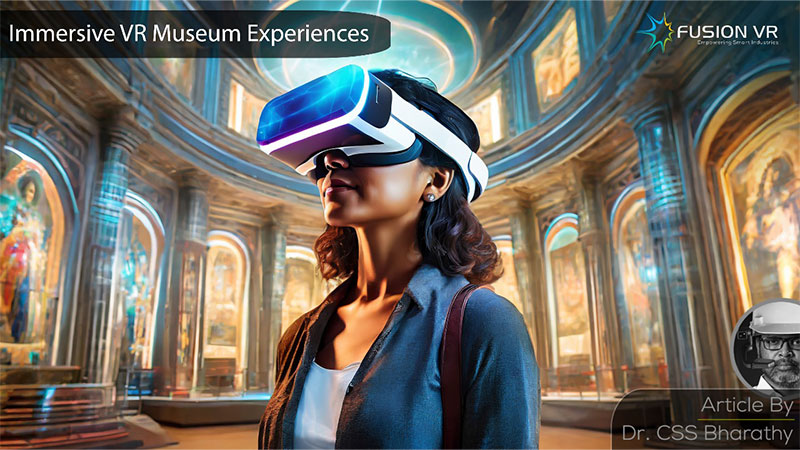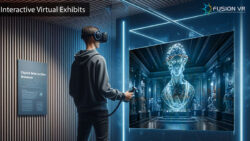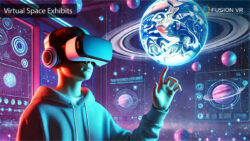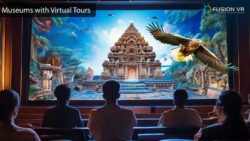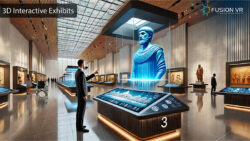Many of you would have heard of online museums and virtual reality experiences in traditional museums recently. The infusion of technology in museums and using digital technologies to bring museums to a wider audience is not new, but a few decades old. There has been a constant endeavor by technology enthusiasts and museum aficionados to broaden the reach and influence of museums. This has led to a continuous stream of innovation that has made it possible to bring the world’s artistic, cultural and scientific treasures into the households of a common man. An immersive VR museum experience is one of them.
An Immersive VR museum is a virtual reality experience that endeavors to replicate the physical experience of visiting a traditional museum. The user sitting at the comfort of their home or classroom with a VR headset feels that they are entering a virtual space that looks, feels and interacts quite similar to how they would feel in a physical museum. The user is able to navigate and get up close and personal with the artifacts, stopping short of actually touching them.
Some of the main features of an immersive VR museum experience include the creation of a hyper realistic environment, such as the entrance, the galleries, exhibition spaces etc. that have the look and ambience of the real museum. These spaces are created by expert 3D modelers and artists which also include 3D models of artworks, artifacts, sculptures and almost everything you might find in a museum, including avatars of museum hosts and guides. The modelers focus on recreating the fine details so that visitors get to appreciate them in the same way as a physical artifact.
Another key feature of the immersive VR museum is the ability to interact with the artifact which enables them to view the details up close, pick it up and examine it from all angles and read or listen to information about the provenance and details of the artifact. In fact this delivers a powerful learning experience for students, who get to explore important historical and cultural exhibits. This experience drives visitor engagement and delivers greater retention of the subject matter. There are many technologies that are making this experience possible. The technological and artistic experts collaborate to deliver this wonderful experience through the virtual realm. Companies like Meta, HTC have innovated extensively to deliver virtual reality headsets that are more powerful, comfortable and easy to use. They come with sensors that track your head movement and adjust in real time the environment around you, thereby creating a sense of presence, realism and immersion in the virtual space, often tricking your brain into believing that it is in a real environment. The optics and high resolution screens bring you close to the realism that you experience in a physical setting.
The computing technologies that enable the development of 3D models is crucial for development of VR environments. Teams of 3D modelers, designers and artists use sophisticated modeling tools to create accurate replicas of artifacts and museum spaces and overlay them with realistic textures to provide an authentic feel to the digitally created world. In addition to this, spatial audio techniques are used to simulate sounds that the visitors experience as coming from different directions and distances. This makes the experience more immersive and realistic. The use of controllers help with the navigation inside the museum space and also enable the visitor to grab objects and artifacts, allowing them to be manipulated as in the real world. The latest 5G technology enables lesser latency and provides a seamless experience for the visitor even if they are in a remote corner of the world. Such advancements make it more realistic and the effective integration of these technologies is what provides visitors with the experience of getting transported to a different time and space in history.
The advent of virtual reality museums means an exciting transformation of the museum experience for the future. While most of today’s museums are traditional, walk through and minimally interactive, it needs the adoption of the suite of technologies to become a VR immersive museum. This requires several steps and the integration of various technologies in museums along with the expertise of museum curators and artists to collaborate and deliver a good VR experience. The first and foremost step is creating the vision. The museum leadership plays an important role in formulating the vision for an immersive VR museum. This vision is important because it helps to develop and drive the strategy needed for the transformation of the museum into an immersive virtual reality museum. A clear guidance is needed on how the integration process works and the extent to which the physical assets of the museum need to be presented in the VR realm. This strategy must be understood and accepted by all stakeholders involved in the transformation.
The laborious work of digitizing the collections then follows. Converting the various physical artifacts, paintings, objects requires digital scanning, complex 3D modeling and high quality professional photography. These digital assets need to be used for developing VR museum experiences along with the storyboard, interactive tools and visitor engagement techniques. The greatest collaboration between the technical, artistic and museum experts happen during this phase.
The strategy should also clearly support the effort to make appropriate choices in VR hardware and software that align with the museum’s expectations and budgetary constraints. The virtual museum space should be designed to be user friendly, visually appealing, intuitive and optimized for a comfortable viewing experience. At every stage of the development process, the focus on user friendliness and quality of engagement should not be compromised. While the design and development process is in progress, the methods and means to perform testing need to be established. This is the place where we need to ensure that the vision, objectives and user requirements established for an wholesome VR museum experience is being achieved. This testing and evaluation provides feedback to the development team to refine and enhance the VR museum experience and appeal.
Another key aspect that museum leaders need to consider is the launch and marketing of the VR museum experience. The power and influence of social media must be leveraged to maximize the awareness and benefits of virtual museums. They would need to take this to governmental, NGOs, corporations and educational institutions to enable a broader spectrum of the people to experience and enjoy it. Last but not the least is to establish the organization and infrastructure to maintain this VR museum system. The engineers, technicians and administrators need to keep an operations team to manage the day to day operational needs and the complex software and firmware upgrades needed to keep the system running at optimal performance levels.
Museums may not always have the right resources and expertise to pull off such a complex transformation. The need to seek the expertise of companies like Fusion VR to guide them through this process, so that valuable time and financial resources are used effectively. We have more than a decade of experience in creating, designing and implementing museum projects across the country. The expertise to execute projects with the collaboration of various stakeholders is important to the success of this effort. The future of museums and their continued viability rests on adopting and integrating digital technologies such as virtual reality. As the world is getting more integrated digitally, there are newer spaces such as the metaverse which will play an important role in how we experience VR in museums. The impact of these developments will change the way we learn, work and entertain ourselves and a visit to the museum would also be quick, easy and fulfilling.

